Reactive polyorganosiloxanes having controlled molecular weight and functionality
a technology of organic siloxane and functional groups, which is applied in the field of photoradiation and/or moisture curing silicone compositions, can solve the problems of limiting the strength of the polymer, the molecular weight of the polymer is difficult to obtain within the desired range, etc., and achieves the effects of avoiding the consumption of silanol functional groups, increasing the molecular weight of the backboned polymer of hydroxy terminated siloxane, and avoiding the consumption of silano
- Summary
- Abstract
- Description
- Claims
- Application Information
AI Technical Summary
Benefits of technology
Problems solved by technology
Method used
Image
Examples
examples
[0114]An illustrative procedure for the preparation of compositions of the inventions is as follows:
[0115]PDMS (1500 g) was steam heated under vacuum using a #2 stirrer for one hour. The mixture was cooled to room temperature, and methacryloxymethyl trimethoxy silane (22.5 g) was added, whereupon the mixture was stirred under vacuum for 10 minutes using a #2 stirrer. Butyl lithium (0.3 g in hexanes, 1.6 Molar) was added directly to the mixture. Stirring was continued under vacuum for two hours. Methacryloxymethyl trimethoxy silane (12.0 g) was added and the mixture was stirred under vacuum for ten minutes.
[0116]Compositions of the present invention were prepared and tested for various properties.
[0117]
TABLE 1Table 1 shows formulations of typical compositions of the invention.ComponentsSample A (%)Sample B (%)Sample C (%)PDMS silanol91.549191.15terminatedMethacryloxy methyl2.012.12.187trimethoxysilaneButyl Lithium0.0180.0180.018Fumed silica5.495.465.47DEAP0.81.291.04Acrylic Acid0.092...
PUM
| Property | Measurement | Unit |
|---|---|---|
| radiation wavelength | aaaaa | aaaaa |
| molecular weights | aaaaa | aaaaa |
| composition | aaaaa | aaaaa |
Abstract
Description
Claims
Application Information
 Login to View More
Login to View More - R&D
- Intellectual Property
- Life Sciences
- Materials
- Tech Scout
- Unparalleled Data Quality
- Higher Quality Content
- 60% Fewer Hallucinations
Browse by: Latest US Patents, China's latest patents, Technical Efficacy Thesaurus, Application Domain, Technology Topic, Popular Technical Reports.
© 2025 PatSnap. All rights reserved.Legal|Privacy policy|Modern Slavery Act Transparency Statement|Sitemap|About US| Contact US: help@patsnap.com



